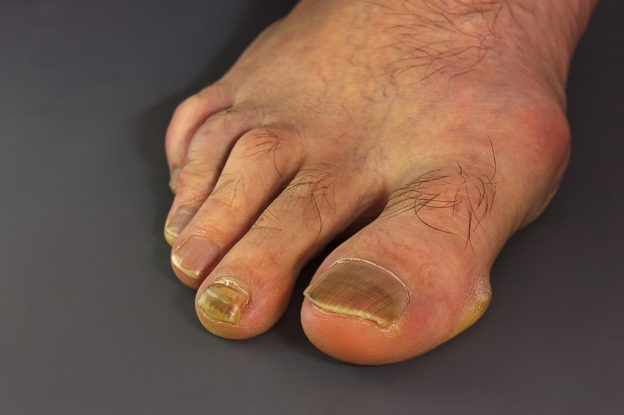By David Blyweiss, M.D., Advanced Natural Wellness
September 21, 2020
I’m not a podiatrist, but as a physician I’ve seen more than my share of feet. Patients come in with blisters, toenail fungus, athlete’s foot, calluses and more.
It always surprises me how little attention people give to their feet… especially men. Folks come in looking perfectly coiffed and neatly dressed.
Then, they pull off their shoes… and there it is!
Ragged, discolored toenails that haven’t been clipped in months. Heels that are cracked and yellow. Calluses that have built up on the sides of their feet.
Some of these conditions can result in a world of hurt – even affect mobility.
For example, toenail fungus can make your nails thick and distorted. This can be very painful and make walking a difficult task. It can also spread to other nails, cause athlete’s and even contribute to jock itch. Worse, if toenail fungus gets into the skin it can lead to cellulitis – a bloodstream infection which can be deadly.
MD Exposes the Hidden Danger to Your Eyes

When your eyesight starts to fail, it's a real problem. Suddenly you can't go to the grocery store... you can't get to the doctor if you have an emergency... you can't meet your friends for dinner…
Your "regular" doctor doesn't have time to keep up with the latest research. And the same goes for eye doctors. They go to school to learn how to fit you for glasses and contacts, but have no way of preventing the damage and loss of eyesight that threatens your freedom and independence.
Let me show you something that explains a LOT about how your eyes work.
In my FREE Special Report, I'll show you a HUGE, untapped resource for your eyes that safely and naturally restores clear, effortless eyesight.
Click here to get started...
So let’s talk a little bit about taking care of those grungy feet. And find ways to get rid of potentially painful conditions that could result in serious infections and mobility problems.
What Are the Causes of Your Foot Malady?
Ultimately, most foot issues are a result of two things: inadequate foot care and poor shoe choices. And let’s appreciate that one quarter of all the bones in your body are in your feet!
For instance, shoes with a narrow toe box and those that slope downward from the heel squeeze your toes together. This can often result in painful bunions. These are bony growths that develop at the joint of the big toe… and boy do they hurt!
Bunions make it painful to walk, compromise foot function and make it difficult to wear shoes. A podiatrist friend of mine told me over 30 years ago, “As long as women wear high heels, I’ll be doing bunion surgery!”
Corns and calluses are frequently cause by shoes that don’t fit properly, or wearing shoes without socks. The repeated friction and rubbing against various parts of the foot doesn’t just cause blisters. Over the long-term, it will result in these unsightly growths.
Tight shoes, socks or nylons that push on your nails can lead to ingrown toenails.
Shoes with hard soles and poor support strain the ligament (plantar fascia) that connects your heel to the front of your foot. This can often be the cause of chronic heel pain.
Athlete’s feet and toenail fungus are aggravated by wearing socks that hold moisture and shoes that can’t breathe. This creates the perfect dark and moist atmosphere that fungus needs to thrive. Plus, it leads to stinky feet.
Are You Suffering From...
- Love handles and a pot belly
- Romance that isn't what it used to
- Forgetfulness and inattention
- Low (or no) strength and endurance
- A sex drive that's shifted into neutral...or worse
If so...you may have Mature Male Burnout. Click here to discover more about this unique condition and what you can do about it.
So pay close attention to your footwear. Any shoes you purchase should have adequate support and a flexible, cushioned sole. And yes, ladies, flats are better than heels.
Your foot should fit comfortably in the toe box. Neither your toes nor the sides of your feet should rub against the shoes. Walk around in new shoes before purchasing to make sure you don’t experience any slipping or chafing.
Save your heels (and yes, gentlemen, cowboy boots have heels) for special occasions. This will help prevent bunions. If you already have a bunion, you know these shoes are going to aggravate it. Should you decide to wear them anyway, I recommend using a bunion pad to lessen the irritation.
If your feet tend to become moist during the day, choose light, breathable shoes and wear them with sweat-wicking socks.
It’s also a good idea to rotate you shoes daily. This gives the pair you wore the previous day a chance to dry out.
Give Your Feet the Attention they Deserve
As far as foot hygiene goes, you brush your teeth and wash your face every day… get a hair trim when it’s needed and shave regularly… so why not give your feet the same attention?
That being said…
- Make sure you wash your feet daily, especially between the toes.
- If you have calluses, corns or scaly areas, soak your feet in warm water. Then use a pumice stone to file down the hard, thick layers of skin. (Make sure not to over-file! It could lead to an infection). Follow-up with a good quality natural moisturizer.
- Trim your toenails regularly, straight across, with clean nail clippers. File down any sharp edges.
- An ingrown toenail can be extremely painful. But please! Don’t dig at it with fingernail clippers, cuticle cutters or scissors. I’ve seen too many patients who do this and end up with a serious infection. If you can’t control it by soaking your feet in warm water followed by the application of cotton under the ingrown edge, please consider having it removed by a professional.
- Aching heels? Try stretching your feet. Sit down with your legs extended, heels on the floor. Reach down and pull your big toe toward you whiling lifting your foot away from the floor. Hold for up to 30 seconds. Repeat three or four times a day. (If you can’t reach your toes with your hands, wrap a towel around ball of your foot while holding it at both ends. Then straighten your leg and pull the towel toward you while keeping your knee straight.)
- If you have toenail fungus or athlete’s foot, make sure you give it the attention it deserves. Apply either cornstarch or antifungal powder after washing and drying your feet.
Over-the-counter anti-fungal creams work well if the infection is on the nail surface or skin. But they don’t work overnight. In athlete’s foot, it takes up to six weeks of daily use for recovery with daily treatment.
Toenail fungus takes even longer, since creams can only be used to prevent new fungus from spreading as the nails grow out. So the final results won’t be seen until the new nail is fully grown, which can take six to twelve months. (If you trim your nails and use a file to thin the nail before apply the cream, it helps improve penetration.)
Natural alternatives to antifungal creams include treating the area with tea tree oil or Vicks VapoRub.
If the fungus has invaded the nailbed, these treatments may not work. In that case, it’s a good idea to take a trip to your podiatrist or dermatologist. They may recommend removing the nail(s) to get rid of the infection.
Remember, “The human foot is a masterpiece of engineering and a work of art” … Leonardo Da Vinci
SOURCES:
Bristow IR, et al. Fungal foot infection, cellulitis and diabetes: a review. Diabet Med. 2009 May;26(5):548-51.
Buck DS, et al. Comparison of two topical preparations for the treatment of onychomycosis: Melaleuca alternifolia (tea tree) oil and clotrimazole. J Fam Pract. 1994 Jun;38(6):601-5.
Derby R, et al. Novel treatment of onychomycosis using over-the-counter mentholated ointment: a clinical case series. J Am Board Fam Med. 2011 Jan-Feb;24(1):69-74.
Tong MM, et al. Tea tree oil in the treatment of tinea pedis. Australas J Dermatol. 1992;33(3):145-9.







